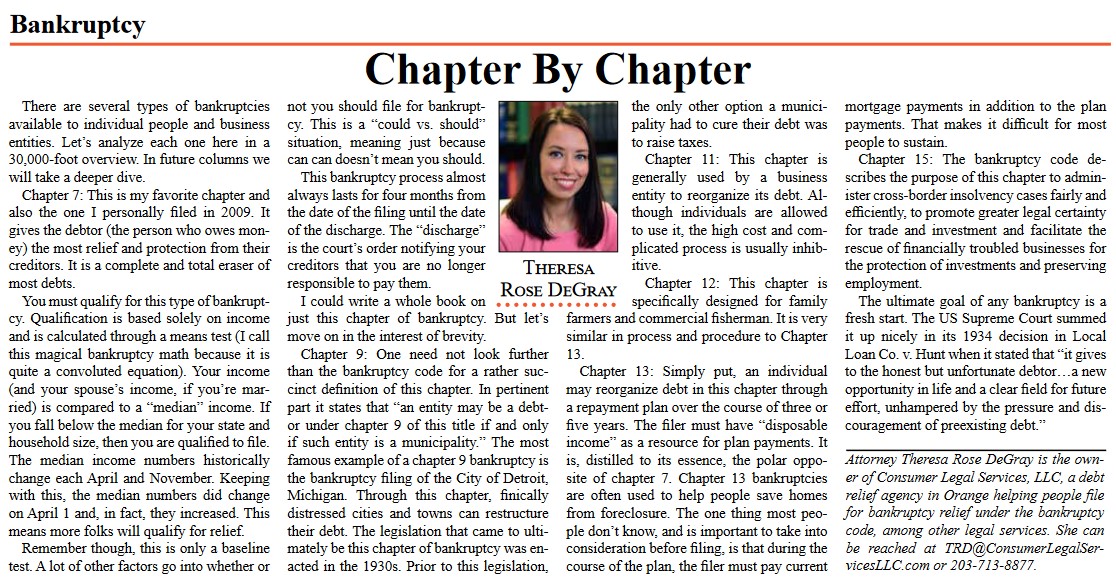There are several types of bankruptcies available to individual people and business entities. Let’s analyze each one here in a 30,000 foot overview and then in future articles we will take a deeper dive.
CHAPTER 7: This is my favorite chapter and also the one I personally filed in 2009. It gives the debtor (the person who owes money) the most relief and protection from their creditors. It is a complete and total eraser of most debts. You must qualify for this type of Bankruptcy. Qualification is based solely on income and is calculated through a Means Test (I call this magical bankruptcy math because it is quite a convoluted equation). Your income (and your spouse’s income, if you are married) is compared to a “median” income. If you fall below the median for your state and household size, then you are qualified to file. The median income numbers historically change each April and November. Keeping with this, the median numbers did change on April 1, 2023 and, in fact, they increased. This means more folks will qualify for relief. Remember though, this is only a baseline test and a lot of other factors go into whether or not you should file for bankruptcy. This is a “could vs. should” situation, meaning just because can can doesn’t mean you should. This Bankruptcy process almost always lasts for 4 months from the date of the filing until the date of the Discharge. The “discharge” is the Court’s order notifying your creditors that you are no longer responsible to pay them. I could write a whole book on just this chapter of bankruptcy! But let’s move on in the interest of brevity for this article.
Chapter 9: One needs not look further than the Bankruptcy Code for a rather succinct definition of this Chapter. In pertinent part it states that “an entity may be a debtor under chapter 9 of this title if and only if such entity is a municipality.” The most famous example of a Chapter 9 Bankruptcy is the bankruptcy filing of the City of Detroit, Michigan. Through this chapter, finically-distressed cities and towns can restructure their debt. The legislation that came to ultimately be this chapter of bankruptcy was enacted in the 1930’s. Prior to this legislation, the only other option a municipality had to cure their debt was to raise taxes.
Chapter 11: This chapter is generally used by a business entity to reorganize it’s debt, although individuals are allowed to use it, the high cost and complicated process is usually inhibitive for individuals.
Chapter 12: Specifically designed for family-farmers and commercial fisherman, this chapter is very similar in process and procedure to Chapter 13.
Chapter 13: Simply put, an individual may reorganize its debt in this chapter through a repayment plan over the course of three or five years. The filer must have “disposable income” as a resource for plan payments. It is, distilled to its essence, the polar opposite of Chapter 7. Chapter 13 bankruptcies are often used to help people save homes from foreclosure. The one thing most people don’t know, and is important to take into consideration before filing, is that during the course of the plan, the filer must pay current mortgage payments in addition to the plan payments, therefore, making it difficult for most people to sustain.
Chapter 15: The Bankruptcy Code describes the purpose of this chapter to administer cross-border insolvency cases fairly and efficiently, to promote greater legal certainty for trade and investment and facilitate the rescue of financially troubled businesses for the protection of investments and preserving employment.
In the end, the ultimate goal of any bankruptcy is a fresh start. The Supreme Court summed it up nicely in its 1934 decision in Local Loan Co. v. Hunt, 292 U.S. 234 when it stated that “it gives to the honest but unfortunate debtor…a new opportunity in life and a clear field for future effort, unhampered by the pressure and discouragement of preexisting debt.”
##
Byline: Attorney Theresa Rose DeGray is the owner of Consumer Legal Services, LLC, a debt relief agency in Orange helping people file for bankruptcy relief under the Bankruptcy Code, among other legal services.

